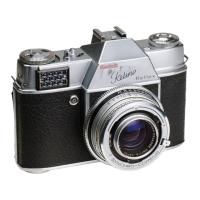The Retina Reflex shutter is internally synchronized for use with flash bulbs and electronic flash. The cable from
the flash gun is plugged into the flash socket of the camera. On releasing the shutter, an electric circuit is
automatically closed through the flash socket, setting off the flash at this moment.
A synchronizing lever protrudes on the side of the shutter.This can be set to X or M.
The Retina Reflex IV has no synchronization lever. Its shutter is X-synchronized only.
Therefore the information on M-synchronization below does not apply to this model.
WITH THE SYNCHRONIZING LEVER SET TO X the shutter closes the flash circuit at the moment when the blades
are fully open. Therefore, electronic flash is synchronized at any shutter speed to 1/300 or 1/500 sec. This
setting may also be used with flash bulbs with short firing delay (i.e. bulbs which require only 4-6 milliseconds -
- thousandths of a second) to reach the peak of their light output with the shutter set to 1/60 sec. With other
bulbs, the fastest usable speed is 1/30 sec.
WITH THE SYNCHRONIZING LEVER SET TO M the shutter closes the flash circuit 16-18 milliseconds before the
shutter blades open to allow for the firing delay of most average flash bulbs. This setting is suitable for normal
flash bulbs at all speeds up to 1/300 or 1/500 sec. The M-setting will not synchronize electronic flash or short-
delay bulbs.
WITH THE SYNCHRONIZING LEVER SET TO V (not on early models of the Retina) the delayed action release for
self-portraits is brought into action. At the same time the shutter works with X-synchronization. This means that
you can work with delayed action and flash at X-synchronization; delayed action with M-synchronization is not
possible.
Exposure Guide Numbers
There is a convenient way of working out exposures with flash, and this is by means of a guide number. When
you buy flash bulbs you will always find the guide number for any speed of film printed on the packet.
To find the correct aperture to use, divide the guide number by the distance between the flash and the subject.
For instance, suppose you find that the guide number of the bulb with the film in use is 160. If you then want to
take a photograph at a distance of 10 ft. from the subject, divide 160/10 = 16. Therefore, the correct aperture
to use is f16. Alternatively, if you want to use an aperture of f8 for any reason, then the correct flash distance is
160/8 = 20. So the flash must be 20 ft. from the subject.
So far we have assumed that the exposures have been for average shots without much subject movement. For
these a shutter speed of 1/30 sec. is long enough to utilize all the light emitted from the bulb. On the other
hand, to arrest fast movements a faster shutter speed is required, such as 1/125, 1/250 or even 1/500 sec.
With each of these speeds a different guide number is needed (usually printed on the flash bulb packet) to
determine the correct exposure. They allow for a wider aperture to compensate for the fact that at fast shutter
speeds some of the light emitted from the bulb is lost.
USING ALTERNATIVE LENSES
The field of view covered by the standard lens is ideal for the majority of subjects. Occasionally, however, a
greater or reduced field of view has distinct advantages. Most Retina Reflex models have an interchangeable
lens system providing alternative focal lengths
for such occasions.
Wide-angle Lens
A wide-angle lens is a lens of shorter focal length; it sees and reproduces more of the subject in front of the
camera than does the standard lens.
Such a wide-angle lens has definite advantages in cases where the practicable distance between camera and
subject is limited and insufficient for the standard lens to record the subject in its entirety. The wide-angle lens
is, therefore, primarily used for architectural photography and interiors.
In view of its short focal length, the depth of field covers a particularly wide zone, even at full aperture. It can,
therefore, be employed with advantage as a quick-shooting lens for general purposes where accurate focusing or
distance-setting would be inconvenient (e.g. insufficient time).
To get a large image, even of a near object, you have to go really close to it. Near objects then tend to dwarf
more distant ones, and the resulting picture shows pronounced perspective effects, In this way, the wide-angle
lens can be used to emphasize perspective.
Telephotography
A tele lens on the other hand has a smaller angle of view than the standard lens. It is of longer focal length, it
reproduces less of the subject in front of the camera than the standard lens does, but on a larger scale.
Such a lens is particularly suitable for subjects that are difficult to approach closely such as animals, children,
architectural detail, sports events, etc. In photographing distant views without near foreground, it brings the

